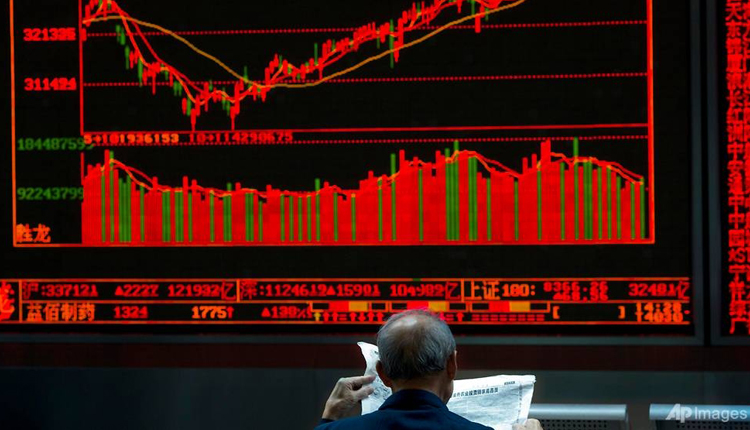Asian stocks were subdued Thursday afternoon as a private survey showed Chinese factory activity contracted in July. Mainland Chinese stocks slipped by the afternoon: The Shanghai composite fell 0.78 percent and the Shenzhen component declined 0.62 percent.
The Shenzhen composite shed 0.549 percent.
Hong Kong’s Hang Seng index also declined 0.68% as shares of HSBC slipped 0.39 percent.
The benchmark Kospi in South Korea returned to negative territory and slipped fractionally. Shares of major chipmaker SK Hynix were up 1.3 percent while Samsung Electronics declined 0.33 percent.
Trade data for July showed South Korean exports fell 11 percent on-year, which was slightly better than the 11.3 percent drop analysts predicted. In particular, semiconductor exports dropped 28.1 percent, Reuters reported. Imports declined 2.7 percent compared to the 8.1 percent drop expected.
The trade numbers came amid an ongoing trade dispute between Seoul and Tokyo. Reuters reported Thursday, citing News1, that South Korea’s foreign ministry said the two countries remained wide apart on the issue following ministerial talks in Thailand.
Last month, Japan placed restrictions on exports of important high-tech materials to South Korea that are used by tech companies.
The situation could escalate further if Japan removes South Korea from a list of trusted trade partners that enjoy preferential treatment. Prime Minister Shinzo Abe’s cabinet plans to endorse Seoul’s removal from the so-called “white list,” which is expected to go into effect late August, the Nikkei business daily reported.
Elsewhere, Japan’s Nikkei 225 traded near flat while the Topix index added 0.1 percent. Australia’s S&P/ASX 200 shed 0.19 percent, as most sectors traded lower.
The MSCI Asia ex-Japan index declined 0.67%.
Chinese factory activity shrinks in July
A private survey showed Chinese factory activity contracted in July. The Caixin/Markit factory Purchasing Managers’ Index came in at 49.9 — slightly better than the 49.6 reading analysts had expected. PMI readings above 50 indicate expansion, while those below that signal contraction.
That number came after official data released Wednesday showed Chinese factory activity contracting for the third straight month in July.
Beijing’s ongoing trade war with Washington was “part of the story” in China’s economic slowdown, according to Fraser Howie, an independent analyst. “I think certainly from a sentiment perspective, the trade war is very significant,” he told CNBC’s “Street Signs” on Thursday.
But it wasn’t the “main driver” of China’s economic story.
“The stories are domestic,” he said. “There are a lot of problems there, China’s not on the brink of collapse. I wouldn’t say it’s nicely humming along, I would say it’s more muddling through.”
The United States and China wrapped up a round of trade talks on Wednesday and will resume negotiations in Washington in early September.
The two sides conducted “frank, efficient and constructive in-depth exchanges” on major economic and trade issues, according to Chinese state-run media Xinhua. The White House said Wednesday that both sides discussed topics such as forced technology transfer, intellectual property rights, services, non-tariff barriers and agriculture.
U.S. President Donald Trump and Chinese President Xi Jinping reached a truce in June at the G-20 summit in Japan after trade talks collapsed in May that prompted a steep U.S. tariff hike on $200 billion of Chinese goods.
Fed
Overnight, the Fed cut rates by 25 basis points in a widely expected move, citing “global developments” and “muted inflation” as reasons. But Fed Chairman Jerome Powell dampened hopes of further rate cuts later this year. He told reporters that Wednesday’s rate cut was “not the beginning of a long series of rate cuts.”
“Powell suggested the Fed isn’t in a long cutting cycle and that the cut was aimed at insuring against downside global risks, he also added that the cut was not necessarily a one-off,” Felicity Emmett, from ANZ Research, wrote said in a morning note.
“This suggests the future policy path will depend on whether global data is feeding negatively back into the US. So far, the manufacturing sector has shown weakness in line with the global slump, but the much larger services sector is holding up,” Emmett added.
Stocks finished lower on Wall Street overnight: The Dow closed 333.75 points down at 26,864.27 while the S&P 500 fell 1.1% to finish at 2,980.38. The Nasdaq Composite closed 1.2% lower at 8,175.42.
Currencies and oil
The U.S. dollar index, which tracks the greenback against a basket of its peers, was at 98.854 after soaring from levels below 98.1 yesterday.
The Japanese yen traded at 109.22 against the dollar after weakening from the 108.5 handle in the previous session. Meanwhile, the Australian dollar changed hands at $0.6848 after dropping from highs around $0.690 yesterday.
Oil prices fell Thursday afternoon during Asian trading hours, with the international benchmark Brent crude futures contract falling 1.05% to $64.36 per barrel. U.S. crude futures slipped 1.21% to $57.87 per barrel.
Source: CNBC
